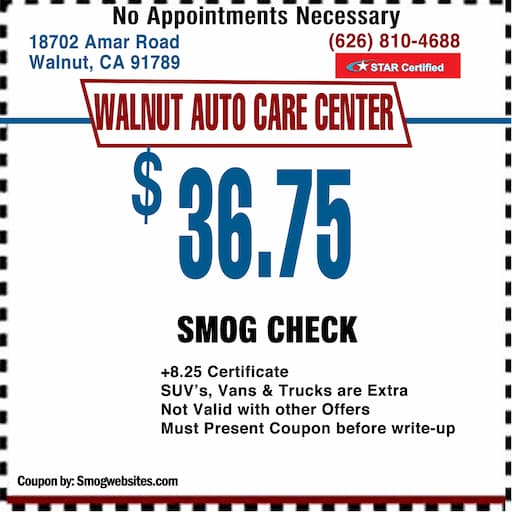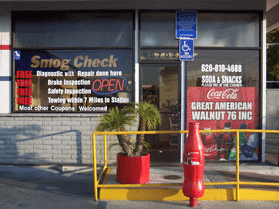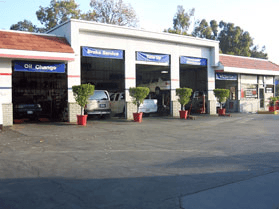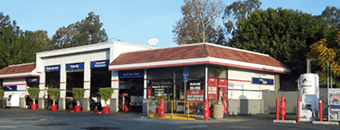- Smog Test Coupon
- We SMOG Test all vehicles
- Regular Smog Test
- Test Only
- Diesel Smog Checks
- Out of State Smog Checks
- Gross Polluter Certification
- DMV Registration Renewal
What is California Smog Check?
The Smog Check Program has greatly reduced air pollution created by millions of cars in California. According to the California Air Resources Board, the program removes about 400 tons of smog-forming pollutants from California’s air every day. With no surprise, the California Smog Check Test is known to be among the toughest smog tests in the U.S. Although greatly reducing pollution created from cars, the California Smog Check Program did not meet its expectations. Studies have shown that the program managed to only reduce the two main polluting emissions by only 12.3% and 9.8%. (hydrocarbon and carbon monoxide )This is a great letdown since it was predicted to have lowered the polluting rate by 25%. The program is inevitably quite unsuccessful, but is still actively running in the state of California. In addition, inefficiency in this program is how the people in California only have to have their car smog checked every 2 years, so they only prepare their car before the day of inspection.
Since people don’t find the need to be aware of their high use of fuel emissions, they are subconsciously polluting far more than they really have to.
California’s automobile emission standards are among the highest in the world. In 1996, California’s government sought to enforce stricter Smog Check tests because the more populated areas of the state were heavily polluting. The state [by whom?] figured that if they zeroed in on the very populated areas of the state, there would be a significant reduction in car emissions air polluting. The government also decided that since some areas needed more attention than others in relation to smog checks, those areas were to have stricter test/ smog laws then others. While inspecting cars for smog, the state recognized the fact that 10-15% of the states smog was coming from the emissions of large cars with large engines. SUV’s put out 43% more global-warming pollutants. This led to truck owners being closely zeroed in on for their car being checked. What was interesting to the government though was how such a heavily populated region like the Bay Area had a fairly low rate on air pollution.
The terms smog check, smog test, and emission check all refer to the same thing. There are two different ways a smog check is implemented: ASM & TSI. TSI (Two Speed Idle) test is used to inspect all wheel drive (AWD) vehicles. The vehicle is inspected at 2500rpm and idle. This is how all vehicles were inspected prior to 1997. ASM (Acceleration Simulation Mode) test procedures involve operating the vehicle on a dyno at 15 mph and 25 mph under load. Operating an ASM test allows for the measurement of a third emission gas (smog) nitrogen oxide (NOx).
A portion of the smog check fee funds air pollution programs. $6 from the fee goes to the Air Pollution Control Fund which funds air pollution reduction programs such as the Carl Moyer Program.
Smog Test Coupon
Special Offer & Coupon for online customers. Please print the coupon and bring it with you.
How To Pass A Smog Test?
There are lots of reasons why your vehicle can fail a smog check. Follow these tips below to insure your vehicle passes the first time.
Make sure your vehicle is performing correctly before arriving at the smog check inspection station.
The chances of your vehicle passing a smog inspection are slim to none if your vehicle is not is good working order. If you do decide to have a smog inspection completed on a vehicle with known mechanical problems you will more than likely lose your inspection fee (unless you are in a state that requires free retests). Save yourself the trouble and get your vehicle repaired prior to having it tested. Also, keep in mind that if your check engine light is on then your vehicle will automatically fail. To investigate the problem, take your vehicle to a repair shop. They will examine your car with a tool that retrieves check engine codes. You can also check with local auto stores to see if this is a service that is available there.
1. Warm Your Car Up
To make sure your vehicle is warmed up and running at the optimal level, drive it for 20 minutes prior to arriving at the smog inspection station. Keep in mind that your engine functions by burning fuel – proper combustion needs adequate time to occur. You can accomplish this by simply driving your vehicle for at least 10 to 15 miles.
2. Take Advantage Of Fuel Additives
To lower your vehicle’s emission levels you can add fuel additives to the gas tank when refueling. The additives reduce your vehicle’s emissions by removing carbon deposits within the engine’s intake and exhaust paths. This allows fuel and air to flow more freely and improves the combustion process and overall engine performance.
3. Check Your Tires
During the emissions test the smog technician might be required to run your vehicle on a dynamometer. If your vehicle’s tires are unevenly worn or improperly inflated then it could cause inaccuracies in the smog test. Verifying your tires are evenly worn and have the correct tire pressure gives your vehicle more stability and produces much greater accuracy during your smog inspection.
4. Change Your Oil
If it’s been awhile since your last oil change, go ahead and change your oil before you get your smog check. If your oil is dirty because of inadequate oil changes then you might fail your emissions inspection because of it. This is due to the fact that the positive crank ventilation system pulls fumes from the oil pan into the engine. If your oil is dirty, so are the fumes.




